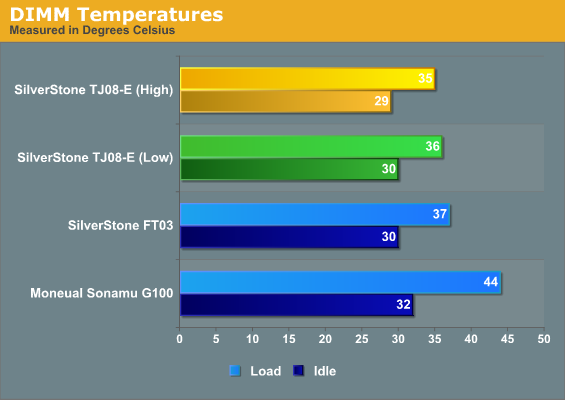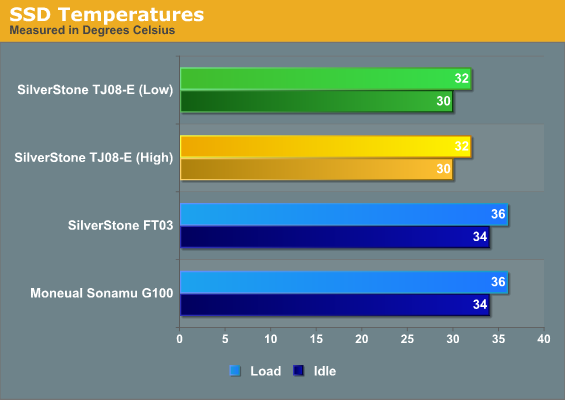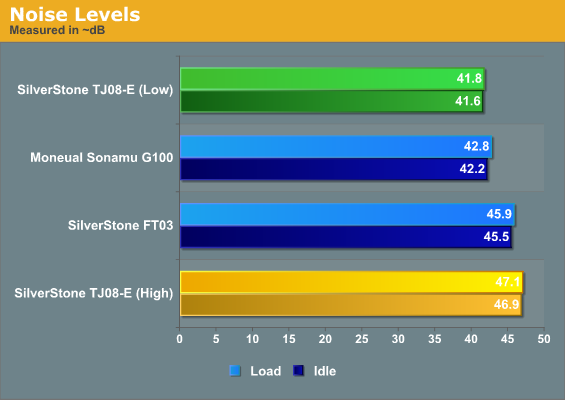SilverStone Temjin TJ08-E: Fat Case in a Little Coat
by Dustin Sklavos on August 4, 2011 1:50 AM EST- Posted in
- Cases/Cooling/PSUs
- Mini ITX
- SilverStone
- MicroATX
- Mini-Tower
Noise and Thermal Testing, IGP
SilverStone includes a small fan control switch recessed on the right side of the face of the Temjin TJ08-E that can be used to set the 180mm intake fan between high and low speeds, and so we tested with both settings. More and more I'm beginning to appreciate fan controls as just a way to make the case quieter rather than actually improving the airflow and temperatures, as you'll see in our results.




Right off the bat the TJ08-E puts in a hell of a showing. Such a good showing, in fact, that it even embarasses SilverStone's FT03. Switching between high and low fan speeds doesn't seem to do much to change thermal performance appreciably; however...

...the low fan speed certainly helps to reduce noise level, with the high speed being the loudest Mini-ITX/Micro-ATX case we've tested. On the other side of the chart, at the low fan speed, the Temjin is the quietest of the cases we've tested. 41dB may seem like a bit much, but our testing cooler has a tendency to run a bit loudly and unfortunately the Zotac board's fan controls are anemic at best. Still, the directed wind tunnel cooling design seems to pay off well when we're using the IGP in our Intel Core i3, but let's see how well the TJ08-E handles the substantially increased thermal load brought by our Zotac GeForce GTX 580.










47 Comments
View All Comments
slagcoin - Thursday, August 4, 2011 - link
You say the case will not work well with dual graphics cards, but you did not even test it. You should test it.I concur with the 160mm modular power supply. Should also find an optical drive about 170mm in length.
I recommend avoiding both CPU air cooling and 3.5" hard drives in the hard drive cage. Put 3.5" hard drives in the bottom and/or media bays. The length of the hard drive cage is perfect for 2.5" hard drives with adapters. Consider SSDs and/or notebook hard drives for the hard drive cage.
Andrew Rockefeller - Thursday, August 4, 2011 - link
I've often wondered if a left hand mounted mobo would be better for passive graphics cards.. heat sink on top seems rational to me. That said, im no master of thermal and fluid dynamics, any benefit may be negligable to none. I see an experiment in my near future.Rick83 - Thursday, August 4, 2011 - link
Well, I"m not sure, because the fans are usually sucking air into the card - in this case they will get the air from the warmer, upper section of the board, whereas normally, the y get it from the bottom, where cooler air is supposed to be.If you"re running passive or with custom fans though, it may be beneficial. Still you have a heat source below the card, with all the VRM and CPU, so it may not be ideal.
Andrew Rockefeller - Thursday, August 4, 2011 - link
I have a passive graphics card. Ran my experiment. It would appear that thermal conductivity has a far greater impact than orientation. 'Negligable to none' confirmed.IMPL0DE - Thursday, August 4, 2011 - link
are barely visible, because you used a white font on bright yellow.PorscheMaD911 - Thursday, August 4, 2011 - link
Thanks for the review, I was seriously thinking about buying this case for my build (parts just arrived today). In the end I went with the Antec Three Hundred instead, and looks like I'll be glad in terms of ease of assembly. This is a really nice looking enclosure though!7Enigma - Thursday, August 4, 2011 - link
Last system I built for my dad's gaming/video rig used the 300. Very spacious and easy to build with. Some sharp corners if I remember correctly, but other than that no complaints and the huge fan on the top on the low setting (fan has low/medium/high) is virtually inaudible and moves a LOT of hot air out.Only long-term issue I can think of is dust issues inside but that's what the air compressor is for once or twice a year.
Good choice.
PorscheMaD911 - Thursday, August 4, 2011 - link
Awesome, thanks for sharing your experience. I'll watch the sharp corners and keep an eye on the dust level!marvdmartian - Thursday, August 4, 2011 - link
1. When photographing a black case with a black interior, illuminate it with a LOT of external light (try to minimize shadows), BEFORE pointing the camera at it. Trust me. Your photographs shows a lot of black on black, with minimal illumination, which showed much less detail than it should have, for this type of review. Remember, some of us aren't kids with sharp eyes anymore.2. Remember to take some angled pictures of the interior of the case. Some of the best details of any case can only be discerned while looking at it from an angle OTHER than straight on. Close ups are also lacking, especially in the drive areas.
3. When reviewing a micro-atx case, doing so with a mini-itx motherboard just seems like cheating to me. You're complaining about crowding, but you really don't have a problem fitting a motherboard that small in the case. Seeing a micro-atx motherboard in there would tell a much better story, especially if you're complaining about space (or lack of).
Nice case, but not really worth that price point, IMHO.
antef - Thursday, August 4, 2011 - link
Dustin,Thanks for this review. I'll be doing a new build in the near future and am very interested in microATX or maybe even mini-ITX because I don't need that many components (no optical drive, only one HDD, SSD, and video card). The TJ08-E looks nice but the difficulty in installation kind of bothers me for something that costs that much and I'd prefer to keep my PC P&C Silencer 610W if I was using a microATX case. Can you comment on something much cheaper such as the Cooler Master Elite 341? I know the materials and maybe thermals won't be the same, but I like the size, layout, and price.